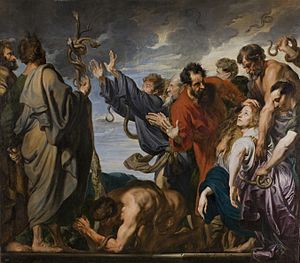The Brazen Serpent (van Dyck) facts for kids
The Brazen Serpent is a famous painting created by Anthony van Dyck between 1618 and 1620. It is an oil painting on canvas. Today, you can see this artwork at the Museo del Prado in Madrid, Spain.
The painting tells a story from the Bible, found in the Book of Numbers. It shows a time when Moses made a bronze snake. He lifted it up for the Israelites to look at. This was meant to heal them from snake bites.
This painting was first officially noted in 1764. It was chosen from a collection belonging to Juan Kelly in Madrid. Anton Raphael Mengs picked it for Charles III of Spain. Experts have studied the painting closely. They found that Van Dyck used both wet and dry painting methods to create it.
Contents
About the Artist: Anthony van Dyck
Anthony van Dyck was a very important artist. He was born in Antwerp, which is now in Belgium. He became a leading painter in England. He was known for his portraits of kings and queens. He also painted many religious scenes, like The Brazen Serpent.
Van Dyck started painting when he was very young. He learned from other famous artists. His style was very grand and elegant. He used rich colors and dramatic lighting in his works.
The Story of the Brazen Serpent
The story shown in the painting comes from the Old Testament. The Israelites were traveling through the desert. They complained about their journey. Because of their complaints, God sent poisonous snakes among them. Many people were bitten and died.
The people asked Moses to pray for them. Moses prayed to God. God told Moses to make a bronze snake. He was to put it on a pole. Anyone who was bitten by a snake could look at the bronze snake and live. This act showed faith in God's power to heal.
Where to See the Painting
The Brazen Serpent is a key artwork at the Museo del Prado. This museum is in Madrid, Spain. It is one of the most famous art museums in the world. The Prado has many masterpieces by European artists. These include works from the 12th century to the early 20th century.
The museum is known for its large collection of Spanish art. It also has many important Flemish and Italian paintings. Van Dyck's painting is a great example of Flemish art from the 17th century.
See also
 In Spanish: La serpiente de metal (van Dyck) para niños
In Spanish: La serpiente de metal (van Dyck) para niños
- List of paintings by Anthony van Dyck


